Giochi dell'Oca e di percorso
(by Luigi Ciompi & Adrian Seville)
(by Luigi Ciompi & Adrian Seville)

|
Giochi dell'Oca e di percorso
(by Luigi Ciompi & Adrian Seville) |

|
 |

Torna alla ricerca giochi (back to game search) |
 |
| Pank a Squith | ||
 |
Versione stampabile
 |
Invia una segnalazione

|
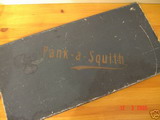 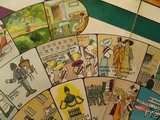 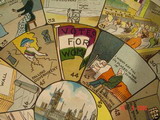 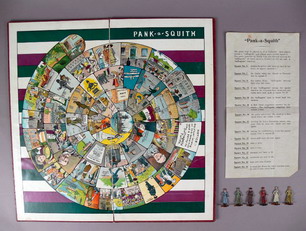 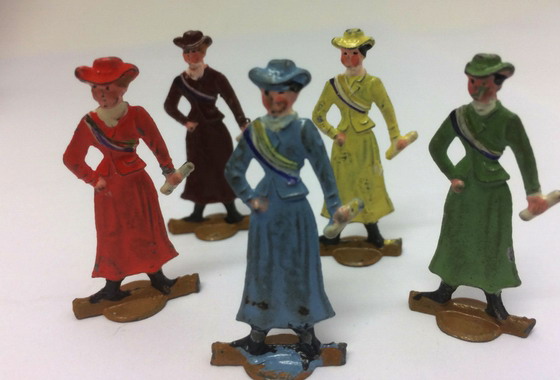 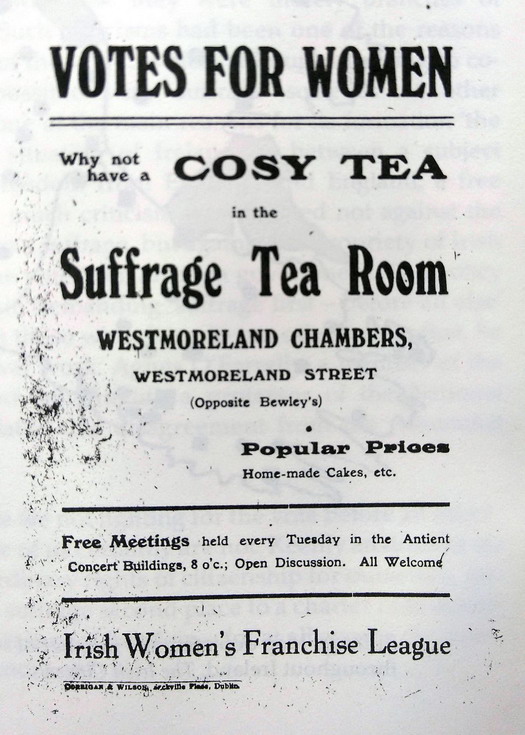 |
primo autore: | Non indicato |
| secondo autore: | Anonimo | |
| anno: | 1909ca | |
| luogo: |
Germania |
|
| periodo: | XX secolo (1°/4) | |
| percorso: | Percorso di 50 caselle numerate | |
| materiale: | carta (paper) (papier) | |
| dimensioni: | 450X452 | |
| stampa: | Cromolitografia | |
| luogo acquisto: | ||
| data acquisto: | ||
| dimensioni confezione: | ||
| numero caselle: | 50 | |
| categoria: | Politica, satira, fatti di cronaca | |
| tipo di gioco: | Gioco di percorso | |
| editore: | Non indicato | |
| stampatore: | Non indicato | |
| proprietario: | Da: Brian Love: “Great Board Game”, Ebury Press 1979 | |
| autore delle foto: | L. Ciompi da B.Love | |
| numero di catalogo: | 309 | |
| descrizione: |
Gioco di 50 caselle numerate, spirale (circolare), antiorario, centripeto. Pank-a-Squith prende il nome da due avversari politici dell'Inghilterra Edoardiana: la Suffragette Emmeline Pankhurst (1858-1928) ed Herbert Asquith, Primo Ministro dal 1908 al 1916. Il percorso a spirale del gioco illustra gli ostacoli incontrati dalla signora Pankhurst e delle sue sostenitrici durante la campagna militante per il diritto al voto alle donne: l'obiettivo era raggiungere la casella 50, ovvero il Parlamento. Grazie ai riferimenti che vi sono contenuti, il gioco può essere datato intorno al 1909: la casella 25 illustra per esempio la manifestazione avvenuta davanti al Parlamento il 25 giugno 1909 da parte dei membri del Women's Social and Political Union (WSPU) un movimento politico per sole donne che si prefiggeva l'obiettivo di ottenere il suffragio femminile nel Regno Unito. La casella 43 fa riferimento all'alimentazione forzata, una misura approvata quello stesso anno per impedire alle suffragette imprigionate di ricorrere allo sciopero della fame. Pank-a-Squith fu commissionato da un produttore tedesco di cui non si conosce il nome, per raccogliere fondi per il WSPU. Il creatore non aveva evidentemente molta dimestichezza con la lingua inglese visto che, alla casella 20, la residenza del Primo Ministro è indicata come Dowing Street invece di Downing Street. Forse proprio per questa matrice tedesca il regolamento è largamente ispirato al Gioco dell'Oca, nonostante non sia prevista una sequenza regolare di caselle positive. La numero 32 (la prigione di Holloway dove furono mandate molte suffragette) ha il ruolo di casella della morte e obbliga il giocatore a iniziare daccapo. La casella 25 celebra la cosiddetta coraggiosa delegazione. L'episodio avvenne il 29 giugno quando la Pankhurst guidò un gruppo di otto donne fino al Parlamento per presentare una petizione al Primo Ministro Asquith. Quando questi si rifiutò di riceverle la Pankhurst colpì un ispettore di polizia. Fuori dal Parlamento centinaia di suffragette si scontrarono con la polizia e danneggiarono diverse vetrine: un episodio che portò all'arresto di 107 donne e otto uomini. REGOLE: non riportate sul tavoliere. CASELLE: alcune con didascalia. REFERENZA 1 (LOVE Brian, pag. 56): "PANK-A-SQUITH. Pank-a-Squith derives its name from two of the chief political opponents of Edwardian England, the suffragette leader Emmeline Pankhurst (1858-1928) and Herbert Asquith, Prime Minister from 1908 to 1916. The board is green and purple, the colours of the Suffragette movement, and the spiral track illustrates the difficulties encountered by Mrs Pankhurst and her supporters in their militant campaign to establish the vote for women. It is possible to date the game to 1909 by references made in the illustrated panels. Frame 25 refers to the demonstration by Women's Social and Political Union members outside the Houses of Parliament on 29 June that year; and the comment in frame 43 to the introduction of forced feeding for hunger strikers during the third quarter of that year. (Remember: if you land on Square 16 you are to send one penny to the Suffragette funds!). Pank-a-Squith was imported into the United Kingdom from Germany. The manufacturer is not known. 1) The objective is to arrive first at Square 50, the Houses of Parliament. 2) This is a game for 2, 3 or 4 players. Each player has one of the special “Suffragette” counters, in the Suffragette colours, and places it outside Square 1. 3) The player gaining the highest throw on the die starts, and then each plays in turn. 4) The game proceeds by dicing with one die and moving the 'Suffragette' as many squares forward as thrown. 5) A “Suffragette” reaching squares with instructions must obey them as follows: Square No. 6: the “Suffragette” dodges the police and must go back to her home on square 1. Square No. 7: the leader takes her friends to Clements Inn on square 17. Square No. 11: this means delay! “Suffragettes” arriving here miss two turns. Square No. 13: if two “Suffragettes” occupy this square together the inspector feels obstructed and sends them both back to square 10. Square No. 14: the “Suffragette” here is forced back two squares. Square No. 18: a Bow Street magistrate reserves his decision. The “Suffragette” alighting here misses one turn. Square No. 20: the police arrest the “Suffragette”. She must go to Bow Street where she misses a turn. Square No. 25: meeting the brave deputation means that the “Suffragette” takes her luck in her own hands and casts again. Square No. 30: if the “Suffragette” has the misfortune to reach this square she must go back to square 22. Square No. 32: worse still! the “Suffragette” must start all over again. Square No. 33: miss a turn. Square No. 36: miss a turn. Square No. 37: the “Suffragette” is chucked out! Back to 35. Square No. 41: mutineers are sent to 42. Square No. 42: here the “Suffragette” misses two turns. Square No. 50: to reach the Houses of Parliament the exact number must be thrown. If an excess is thrown, the “Suffragette” must move back accordingly. 6) The first “Suffragette” to reach the House by an exact throw wins the game. REFERENZA 2 The issue of female suffrage was one of the major unresolved questions in western democracies in the early decades of the twentieth century. Many activists looked to Australia as the exemplar of progressive democratic leadership, because Australian women had won both the vote and the right to stand for parliament at a national level in 1903. Australians were also active in suffrage campaigns overseas, particularly in the United Kingdom, in the years just prior to the First World War. The formation of the Women’s Social and Political Union (WSPU) in 1903 marked a break from the politics of demure persuasion that characterised the earlier period of the suffrage campaign. Frustrated at the lack of progress from years of moderate speeches and promises about women’s suffrage from members of parliament, Emmeline Pankhurst, founder of the WSPU,and several colleagues decided to abandon these patient tactics in favour of more militant ones. Emmeline later wrote that ‘Deeds, not words, was to be our permanent motto.’ (E. Pankhurst, My Own Story, 1914, p.38). Over several years the actions of WPSU members became increasingly physical and violent. Emmeline herself was jailed several times for her actions, the first time in 1908 when she tried to enter Parliament to deliver a protest resolution to Prime Minister Asquith. She spoke out against the conditions of her first incarceration, protesting at the tiny amounts of food she received, the vermin, and the hardship of solitary confinement. In 1908 two WSPU members, Edith New and Mary Leigy, threw rocks at the windows of the Prime Minister’s home at 10 Downing Street. Emmeline Pankhurst expressed her approval of the action. In 1909 the WSPU added hunger strikes to their list of resistance tactics. As various members were jailed they expressed their horror at the conditions by refusing food, thus helping to publicise their cause. Prison authorities often force-fed the women through tubes inserted in their nose or mouth, a painful technique that was condemned by both suffragists and medical professionals. Pankhurst went on many hunger strikes and wrote of the ordeal: ‘Holloway became a place of horror and torment. Sickening scenes of violence took place almost every hour of the day, as the doctors went from cell to cell performing their hideous office.’ (E. Pankhurst, The Suffragette Movement, 1931, pp. 251-2). The Women’s Press was founded as the WSPU’s publishing arm, producing the weekly newspaper Votes for Women from 1907. From 1908 The Women’s Press stocked various purple, white and green products and novelties such as brooches and badges, scarves, ties, hatpins, flags and so on. The colour scheme had been devised by the co-editor of Votes for Women, Emmeline Pethick-Lawrence, who wanted suffragists to cover themselves in the colours which, she said, represented “purple…for the royal blood that flows in the veins of every suffragette…white stands for purity in private and public life…green is the colour of hope and the emblem of spring.” (D. Atkinson, The Purple, White & Green, p. 15). The WSPU shops also stocked various games, created by several London manufacturers. Amongst these was Pank-a-Squith which was first advertised in Votes for Women in October 1909 for one shilling and sixpence. The pictures on the 50 squares of the Pank-a-Squith game depict the events and issues that concerned the WSPU at the time. The 10 Downing Street stone throwing incident is shown, as are the arrests of Emmeline Pankhurst and the hunger strikes and force feeding of jailed suffragettes. Although there is no solid evidence that games such as Pank-a-Squith raised much money for the suffrage cause, there is no doubt that it is an example of some of the earliest political merchandise relating to suffrage. It is also a highly significant reminder of the radicalism espoused by suffragettes in this era, and relates directly to the suffrage movement in Australia. |
|
| bibliografia: |
1) LOVE, Brian: “Great Board Game”, Ebury Press 1979. 2) SEVILLE, Adrian: "L'arte dei giochi da tavolo. Oltre un secolo di storia e divertimento dalla fine del Settecento all'inizio del Novecento." Edizioni White Star, 2019. |
|
Vai alla ricerca giochi Vai all'elenco autori